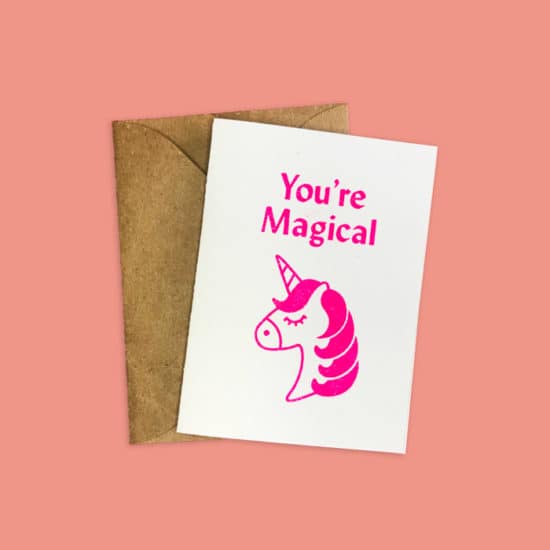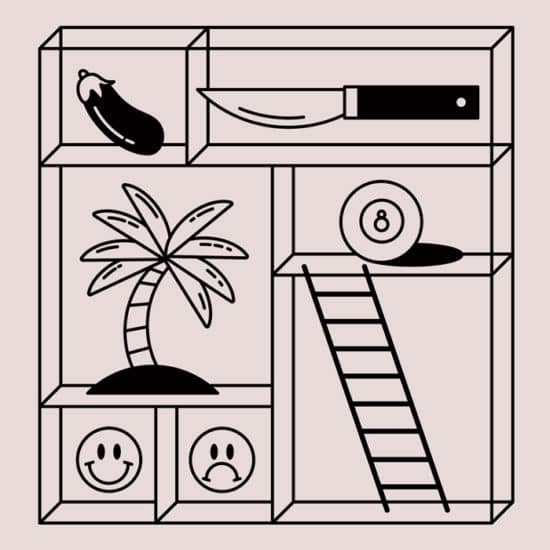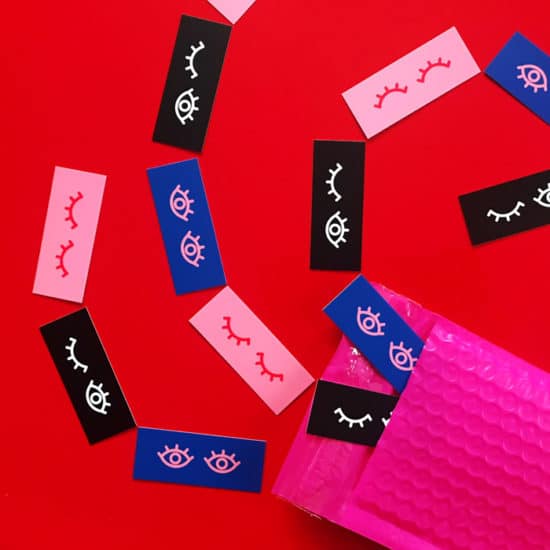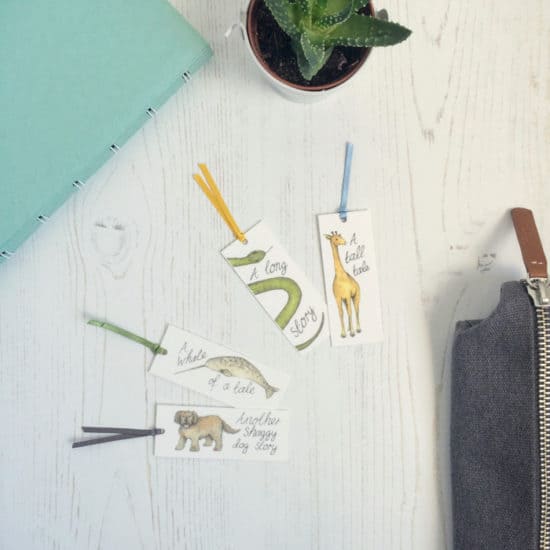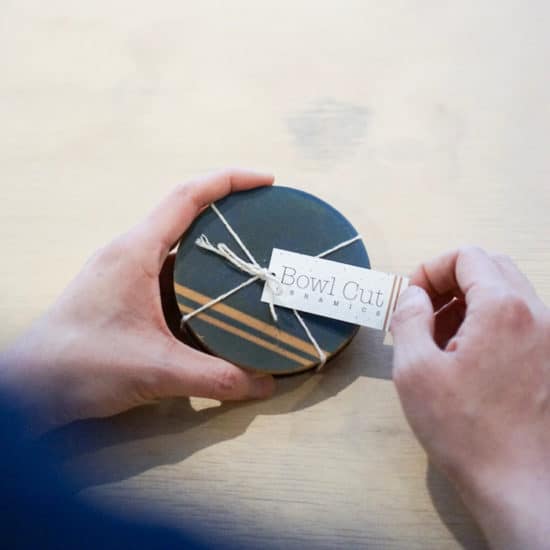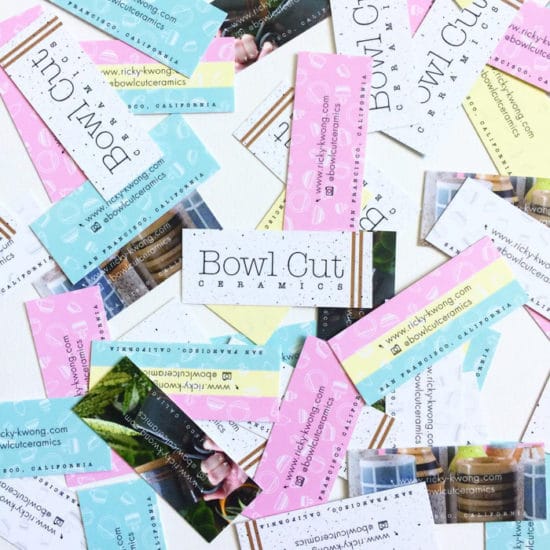Spread the word with Flyers
Whether it’s promoting a charity, getting a laugh, or simply saying thanks—these Flyers take analog advertising to a whole new level.
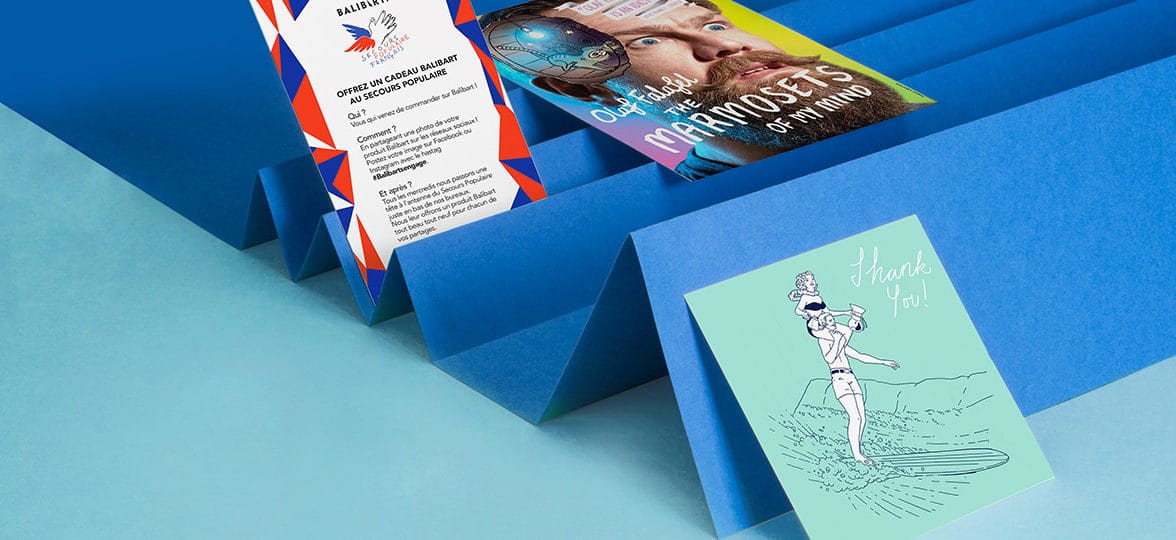
Whether it’s promoting a charity, getting a laugh, or simply saying “thanks”—these customers show us that Flyers are a classic way to get the word out.
In the age of digital promotions and online ads, it can be hard to stand out amongst the crowd. And, that’s why sometimes it can be good to go back to basics. Here are 3 examples of how to take classic Flyers to a whole new level.
Olaf Falafel
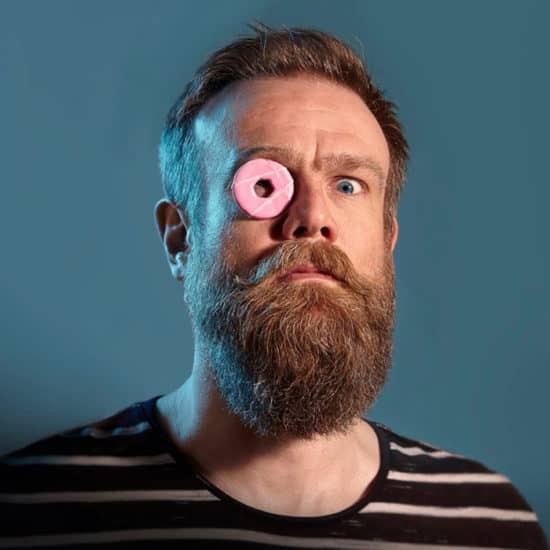
Olaf Falafel is a Swedish stand-up comedian, author, and illustrator. Self-branded as “Sweden’s eighth funniest comedian,” Olaf’s comedy ranges from viking humor to jokes about his facial hair. Olaf caught our eye when he posted his flipbook-style Flyers to promote his comedy show, The Marmosets of My Mind. We’ve seen some great uses of Printfinity over the years, but animated Flyers? Touché, Olaf Falafel. Touché.

“The fact that they are flipbook-style animations makes people stop and pay attention,” Olaf tells us. “This is particularly useful at festivals, where people are constantly thrusting bits of paper in your face.” The show Flyers were printed with 8 different designs, showing a marmoset exercising on a spinny-wheel inside Olaf’s brain. “The prints are printed and collated in the correct order, so I can take them out of the box and flip through them to show the animation.”
Olaf Falafel is not new to the concept of flipbook Flyers. “This is the second year I’ve made animated Flyers,” Olaf tells us. “Last year my eyes moved while cheese spun on my fingers, which promoted my show ‘Olaf Falafel and the Cheese of Truth.’ I got some great reactions from fans on social media!” First cheese, then marmosets—what could be next for the intrepid comedian? We have a feeling we’ll be checking back in soon to find out.
Get the word out there with Flyers
Panopli
Panopli is an online platform that allows artists from around the world to sell their work as prints, t-shirts, totes, and more. Users can choose the products they want to make and create a custom online shop to sell their work. Founded by two French entrepreneurs, Maxime Delmotte and Adrien Salamon, Panopli came about from their shared desire to enable artists to ‘live by their art’.
In addition to helping artists, Maxime and Adrien wanted to make a difference by giving back to a good cause. One of Panopli’s biggest sellers, Balibart, came up with the #balibartsengage hashtag campaign where artists can share their work on social media. For each social media post, Balibart donates a product to a French charity. The company promotes the campaign by sending Flyers to each customer. “A physical product is the most effective way to catch their attention,” Adrien tells us. “Even with all the digital promotion, nothing can replace an actual Flyer.”
The #balibartsengage Flyers were designed by Panopli’s art director with the aim of making it simple and effective. The Panopli community has high praise for the good cause. “Our customers love that we give them the opportunity to have a real social impact,” Adrien says.” The company has given away hundreds of products to charity so far, with hopes to continue the charitable work for as long as they can.
Latigo Coffee
In need of a midday perk? You’re in luck. Los Angeles-based subscription coffee roaster Latigo Coffee has built a business on shipping fresh-roasted coffee anywhere in the US. With bi-weekly batch shipping and a range of coffee plans to choose from, Latigo aims to bring the finest coffees right to your front door.
The Latigo brand prides itself on being advocates for the outdoor life, urging customers to “grab some beans, get outside and get after it.” They also encourage customers to share photos of their adventures on Instagram using the #latigocoffee hashtag. A new era of backcountry baristas is born.
For a company whose business revolves around packaging and shipping, it’s no surprise that Latigo places a lot of emphasis on customer experience. “The unboxing experience was important to us from day one,” Latigo founder Mark Finster explains. As a token of appreciation to each customer, Latigo includes a “thank you” Flyer in each package, with an illustration of a tandem surfer and a chemex coffee maker. “The Square Flyers from MOO were the perfect fit (literally) for our packages,” Mark says. “People love receiving handwritten notes! These box inserts are integral to the business.”
Print Flyers to delight your customers
Halla Hákonardóttir and Helga Kjerúlf travel the world finding inspiration for their eco-friendly textiles. But how did they make their collaboration fly?
Sharing a passion for eco-friendly textiles and an urge to spread their message through design projects with a bold sense of humor, Halla and Helga decided to join forces after meeting at art school as few years earlier. Ideas flew, a firm bond was formed, and USEE was born – which is “all about good things and crazy vibes.”
Today, the pair’s fashion delivers a timely message about sustainability and boasts a uniquely Nordic feel. But what’s the inspiration behind their quirky collaboration? And how do they make sure their material-led designs stand out from the crowd? MOO caught up with Halla and Helga to find out what makes their brand tick.
How did you two meet, and what was the lightbulb moment that made you want to become creative partners?
We met at art school, I was studying architecture and Halla was studying fashion design. After finishing our art degrees we both did our own thing and traveled around for a few years. Then, at the exact same time, we both moved back to Iceland. We were hanging out together a lot over coffee, and quickly discovered many of our dreams and ideas were similar. We had a real good feeling about working together.
Where did the drive and ambition to launch USEE come from?
We have a lot in common when it comes to our aesthetics and views on sustainability. We started to visualize our concept and our studio, then one day we said, “Let’s just start this.” We’re both pretty impulsive, so that might’ve helped too!
What’s the message behind USEE’s unique designs?
Our design projects are mainly made from waste and/or second-hand materials. They’re conceptual and radical, but with a twist of humor. We use them as a way of informing people about the fashion industry and the growth of fast fashion and mass production.
We have to see changes in buyers’ behaviour, but designers also have to take responsibility. We want to show our generation that recycled and redesigned clothes can be fashionable, while making people smile. Every product we make has a message behind it, like our swimwear. You have to take a look!
Where do you source your materials from?
We visit a lot of charity stores, where we buy second-hand fabrics, zippers, threads and buttons. We’ve found some amazing fabrics, and people are surprised when we tell them where they came from.
REMIX is our streetwear clothing line – we make pants from curtain fabrics and dresses from sheets and we create rings, earrings and necklaces from discarded mirrors for our jewelry line.
What’s your biggest source of inspiration?
Sometimes ideas come from the books we’re reading, the music we’re listening to, our travels, movies or whatever grabs our attention.
From an historical point of view, we’re attracted to art, design and architecture from 1920 through 1980. We particularly love the art deco era – we recently went to Miami, where the art deco streets on South beach are amazing! We absolutely loved them.
Otherwise, we take inspiration from the everyday. Random stuff in our homes, or things that are a bit exotic to us, but normal to other people – like palm trees and fans. No one in Iceland owns a fan!
What are you doing to make sure you’re building smart working habits while building your brand?
It’s taken some time to get into a rhythm and organize our working habits and hours. It can be difficult to set limits when you work for yourself, but we’re getting better at it. It’s one of the reasons we travel a lot – we’re busy brainstorming ideas, but our computers are left at home.
You exhibit and sell your work at art galleries and pop-up stores – what are your top tips?
You need to find a way to stand out from the crowd – to be juicy and eye catching. For that, Business Cards are crucial.
When you’re selling expensive products, people tend to want to have time to think before they buy, so it helps to give them our Business Card so they can contact us if they decide to buy something later on.
It can be so easy to be forgotten in the black hole of the cyber world. We think it’s important to have something physical to give out – and of course, ours are made from recycled cotton!
What are your brand values, and how did you decide on them?
Being ethical is core to our brand, celebrating the importance of color in design, and a sense of fun. Every product has to have a meaning, a hidden message or somehow raise awareness.
We like to think of our brand as a person who’s sustainable, listens to music and loves having fun. This person we thought up helped us build up our values.
How do people react to your products?
A lot of people tell us we’re fresh, colorful and have a great concept. It’s been better than we dared to hope for in the beginning. It would’ve been difficult to achieve everything we’ve done without people believing in us.
What are your tips for aspiring entrepreneurs wanting to start their own business?
Just start! Go slow, and let yourself develop and grow. Don’t overthink or be scared of making mistakes. That’s how you learn. It’s better to make wrong decisions while you’re still a small brand.
Don’t take yourself too seriously, but don’t belittle yourself. Also, trust your instincts and listen to them. When we’ve made wrong decisions, we haven’t seen them as mistakes, because everything we’ve done has brought us to where we are today.
Stand out from the crowd and design your own Business Cards
How the company helps talented designers over the globe connect and collaborate with clients who need custom design.
99designs is a creative platform powered by people from around the world that helps businesses get better design. MOO spoke with 99designs’ Laura McLeod to find out the story behind the unique platform, and why she thinks design is the best way to showcase your brand.
Turning a craze into a business
Like the brand itself, the inspiration behind 99designs was beautifully simple, with design at its heart. In 2008, Matt Mickiewicz and Mark Harbottle, co-founders of web developer hub SitePoint, noticed a game of Photoshop Tennis being played on their design forums.
Graphic designers would exchange images back and forth, essentially creating a design competition on the forum. The most creative player would be declared the winner and, usually, the game would end there—the designers were only in it for their love of great design.
But when Mickiewicz and Harbottle spotted this low key-craze, the seed of an idea was planted. They envisaged a community of designers that could be tapped into by companies looking for new logos to enhance and communicate their brands. The platform would enable passionate designers to broaden their reach and work on projects that would further their design careers.
Today, 99designs connects its designer community with projects that extend beyond logos, encompassing everything from websites to book covers. By keeping the designers it champions at the heart of the business, 99designs has, to date, earned them $210m USD.
“Our mission is to help people create and grow by design. For designers that means we want to help them get access to great clients and quality design no matter where they are in the world,” McLeod says. “We want to give them the best platform to find work online.”
The essence of branding
On 99designs, businesses can work with designers two different ways. A 1-to-1 Project matches clients with a designer who fits their brand—a great option for businesses that have a clear idea of what they’re looking for. Meanwhile, a Design Contest presents clients with multiple concepts from designers around the world, which is perfect for exploring different design perspectives.
“Your brand is the essence of everything you do — how you look, act and talk to your customers, and how consistently you do this,” McLeod says. “Successful brands work very hard to maintain consistency because it’s what conjures an emotional response in people — which establishes trust, loyalty, and a community.”
And how a business executes this through design, McLeod thinks, is crucial. “It doesn’t happen overnight—it’s a journey and we love helping people get designs they love,” she says. “You have to start somewhere. Getting started with your logo is most often the first step in showcasing your brand through design.”
“For businesses — especially startups — it’s important to bring this to life in a way that highlights your company name, values, personality, and positioning. Do this well, and your brand will resonate well with the people who need you most.”
In 2016, 99designs went through its rebrand and tapped into its global design community to spark fresh ideas and inspire the new look for the company. Over 4,000 designs were submitted before the current, simple logo was chosen as the winner. “It was such an amazing response from the community, and we’re so happy with the result,” McLeod says.
Community matters
As for its own journey, 99designs has ensured its global staff of over 120, split between California, Berlin and Melbourne, have been on board with the company’s culture and core values every step of the way. They include mantras “Design has no borders,” “Put people first,” and “The journey should be fun”—all of which encapsulate the company’s ethos of creative collaboration.
“There’s something very special about the 99designs community,” McLeod explains. “We live and breathe our brand. We love design and seeing new ideas come to life. It comes through our actions and how we interact with each other on a daily basis.”
To aid this interaction, 99designs’ office spaces cater to creativity, with requisite touches such as ping pong tables, catered meals and terrariums throughout. And there are plenty of other initiatives on offer to inspire the team.
Each year, 99designs hosts Celebrate Design Day, a time for the brand to celebrate everything it stands for. “We celebrate on September 9 and use this time to give something back to the community, get creative, and get excited about design without borders,” McLeod explains.
“It’s a great way to bring everyone together, reflect and come up with new ideas.” Plus every month, 99designs selects a group of not-for-profits to receive design support for free.
“We take care with how we are expressing ourselves to others; from how we present our job ads to the designs we select for the backs of our business cards,” McLeod adds. “We also always ensure we credit the designer when their work is featured anywhere. We’re here to showcase them.”
Sharing the 99designs vision
With a strong visual identity at the core of the business, Laura sees MOO Business Cards as a key part of how 99designs shares its own brand values.
“We selected some of our favorite designs from our MOO Business Services platform for our Business Cards,” McLeod explains. “It’s way of showing show the diversity, quality and choice that’s available from the wealth of talent in our designer community.
“Stylistically, we feel it’s important to champion all sorts of different approaches, so we like to mix it up as much as we can and allow the talent of our designers to speak for itself.
“I always let people pick the card they like most, and they often struggle to choose, because they’re all so inspiring. I loved getting my cards when I started here and I love to give them away. They’re the perfect extension of our brand.”
Tell your brand story with MOO Business Services
At MOO, we’ve been helping people make their mark in the world with amazing quality print products for over a decade. And as our customers have grown, so has our service offering. That’s why for bigger businesses—with 10+ employees—we now offer MOO Business Services. It’s MOO + benefits. MOO Business Services combines dedicated account management with an easy online ordering platform and expert design services. It’s a complete package for businesses to give you more brand control and consistency—while saving you time, stress, and money in the process.
Fill out the form here and a friendly Account Manager will reach out to you.
Spring has sprung! The birds are singing, the sun is shining, and… you suddenly have the urge to clean everything in sight.
Why do we clean in spring? We may never know––but might as well harness that energy. Since you’re already in the mood to organize, it’s time to tackle the most crucial area of your life––your business. This spring, use that cleaning compulsion to make your office into tip-top shape:
1) Get real
Remember those New Year’s resolutions? It’s time to see how close you are to hitting the mark. Have a team meeting to celebrate the milestones that you’ve hit. (And readjust the goals that might seem unrealistic.) While that process might take more time now, making the changes will help you avoid some rough patches later in the year.
For some inspiration on how to keep this type of meeting short and sweet, click on over to this blog post.
2) Ask for tough love
You’re almost in H2, which means it’s the perfect moment to see how your key customers and partners feel about your performance. Encourage feedback by sending an an online survey to your email list with services like Survey Monkey. If you have thick skin, give bonus points for the most negative feedback. While it might hurt to receive, you can’t strengthen your weak points if you don’t know what they are!
3) Check in with the competition
Unless you’re some sort of magical unicorn, you have competition. Lots of it. In order to stay on top, you need to know how other businesses are positioning themselves in the market. Has anyone recently revamped their brand? Is there a hot new contender in the game? Write all of that up in an audit on industry trends, then analyze how your business can stand out and stay ahead.
4) Get unstuck
Did you know that between 40 and 60 percent of all work interactions involve the people who sit near your desk? That’s a ton of time! Use spring as an excuse to switch up office seating, make room for new ideas, and foster new bonds within the company. But before you go too crazy, take a tip from Entrepreneur and think about the type of company that you have. As writer Gwen Moran says, “If you have employees whose work requires privacy, such as a law or financial services firm, shifting to an all-open floor plan to encourage interaction could be counterproductive.”
5) Yeah, you know this one
Since you’re moving seats around, you must as well, you guessed it, actually clean. That includes getting your notebook organized and sorting this pile of Post-it notes, too.
To make things a little more interesting, use the moment as an opportunity for team bonding! Ask your staff how they’d like to improve the space, then order your supplies––including food––and get to work. Dancing to loud music and singing into mop handles is wholeheartedly encouraged.
Spruce up your business on brand-new Business Cards.
Today, shopping online is something we do almost without thinking, but back in the day, things were a little different for the pioneers of online retail.
1. Broadband was not a given
Although broadband was available from the early 2000s, it was expensive and restricted to real tech enthusiasts. So until the mid-2000s, for most folks going online was an active process rather than a standard state of affairs. They had to connect the modem to their computer and dial-up using a phone line, which charged by the minute (and tied up the landline too).
As a result, they needed a really good reason to log on to the World Wide Web, such as sending emails or looking up something specific. The type of always-on browsing and sharing behavior we see today is a very recent way for online sellers to get noticed.
2. There was basically just eBay and Amazon to choose from
And they were quite, quite different to the sites we know today. The basic idea of selling on eBay or Amazon Marketplace hasn’t changed a lot since then, but the number of people using it has mushroomed. According to BigCommerce, e-commerce sales have grown more than 18,000% since 1997.
3. Photos are way better now
If you were selling something online circa 2002, you would need to find somewhere to host your images, since bandwidth was expensive and auction sites didn’t offer free image hosting. Typically, you would need to upload your images to a separate service and then link back to them. Also, they’d be from your digital camera, since even a very fancy phone wouldn’t have a decent camera, so you’d need to connect it to your computer with a cable and download the images.
4. We didn’t have smartphones
Speaking of phones, it’s amazing to think that just a few years ago buying things on a mobile device was pretty much unheard of. Your customers would have been browsing on desktops and laptops, but not on the bus or walking down the street. Until Apple launched the iPhone in 2009, smartphones weren’t really a thing, let alone making purchases with them. These days, mobile sales account for 30% of online shopping in the US.
5. Before social took off, it was hard to find reviews
Facebook launched in 2004, but it wasn’t until several years later that it broke out from its niche as an academic network and went mainstream. Twitter was even later to the party, launching in 2007.
So in the early 2000s, the social landscape featured the likes of MySpace and Friends Reunited, neither of which were well set up for product reviews and recommendations. (You were more likely to find emo selfies and lists of favorite songs than mentions of brands and products.) Although review sites existed, the modern ecosystem of brands, social users and comments on products just didn’t exist.
6. There was no such thing as usability
The websites of yore were plagued with things like frames, applets, and widgets, all of which made browsing tricky when put in the hands of less-skillful web designers. In those days, the internet was a niche interest for techy types, and not optimized for beginners.
As a result, it could take real determination for a customer to fight their way through to completing a purchase. A study by Nielsen Norman Group in 2001 found that just 56% of customers attempting to buy online actually made it through the checkout process.
Selling online is a picnic compared with the olden days, but you can still give yourself an edge with some real-world appeal, like a set of flyers to add to customer packages.
What happens when a centuries-old craft meets leading-edge technologies?
Fonts are ubiquitous. Just look around you—chances are, you’ll see multiple typefaces across different objects, products, and displays. For type designers, making a font that works well across these mediums and surfaces is a huge task that many tend to overlook. And the hardest part? These mediums are always changing.
So what’s next for the future of fonts? Industry-leading typeface design company Monotype has some predictions. We spoke to Monotype’s Senior Director of Creative, James Fooks-Bale, about some of the game-changing new trends that will have an impact on type:
1. Virtual and augmented canvases
Our mobile devices are ever-evolving. As a result, fonts that can scale to the sizes and specifications of these devices is key for a rich user experience. With the rise of augmented reality (AR) and virtual reality (VR) devices and applications, Fooks-Bale envisions scaling fonts to a multi-dimensional level. “Having fonts that hold up well in new digital environments will be a must in the next couple of years. This not only applies to the type design, but also to rendering quality and legibility, which varies constantly in AR and VR settings. Monotype is really pushing the envelope on that front.”
2. Variable fonts
Variable fonts are non-static fonts that can respond to different data inputs. “Monotype has seen more variable font families, and their potential appears to be limitless. There are a whole host of different use cases into which they could fit,” Fooks-Bale tells us. For example, variable fonts can change from the brightness of the sun on your device, the angle of your screen in relation to your face, or how much movement is going on within your device.
3. A font for every language
A font that scales to every language sounds like a massive challenge—and it is. But Monotype was up for the challenge. “The SST font is one of the more ambitious things I’ve seen in a long time,” Fooks-Bale shared with us. The font design teams developed glyphs that adapt to 100 scripts in nearly 800 languages. “We’re seeing global brands that don’t want to be limited to just one region and they want a sense of universality when they communicate their brand to all parts of the world. Their palette and typefaces need to scale with them.”
4. Custom fonts
Having a brand voice is one thing. Communicating that voice through branding is another. That’s where custom fonts come in. “More and more, brands are trying to find their own voice that differentiates them from competitors in their industry,” Fooks-Bale explains. Monotype offers custom font design services to help brands create a unique identity that matches the company’s personality or offering. But if a brand doesn’t want to undertake a custom font project, they can select from Monotype’s library of more than 2,500 font families, or even make design changes to an existing font to meet brand needs.
For Fooks-Bale, these font trends mean the type industry is alive and well. “That’s one of the most exciting things about our industry—type is an ingredient that needs to evolve in the same way that businesses need to evolve to stay ahead of the curve.”
Print your fonts on MOO Business Cards
That bolt of brilliance that struck you in the shower this morning – is it a ticket to entrepreneurial success, or a thought-exercise that’s better left unexplored?
All successful businesses were once just a spark of an idea, a “what if..?” moment that shifted a future founder’s business brain into gear. But a great idea is just the tiniest of first steps. Some are viable, some are non-starters – and others just need a little bit of luck, funding and faith.
So how do you tell the difference?
Mostly by asking yourself the tough questions that will expose the weaknesses of your idea – or reveal hidden strengths. Questions like “Have you worked in this industry before?” or “Have you thought about how you’ll get funding?” or even simply “Who will buy this product?”
Here are some of the areas to think through when you’re putting your brainwave through its paces. If you can borrow a friendly pair of ears to help you sift through all the considerations, so much the better, as another person can offer objectivity as well as bringing their own knowledge to the table.
Scope
First things first – what is it? Have you dreamed up an app? A product? A service? Ideas can fly thick and fast in the world of your imagination, so it’s worth reining them in, putting them on paper and finding out where the edges of your concept are.
Try writing an elevator pitch for your idea. (That’s you explaining it to a layperson during the time it takes to ride an elevator a few floors.) See if you can crystallize it into one or two sentences in a way that’s clear and compelling. Would it fit onto the back of a Postcard or a Flyer? Could you even squeeze it onto a Sticker? In most cases, boiling your idea down to the essentials is more difficult than it sounds.
Another approach is to define the minimum viable product – i.e. the most basic working version of your idea made reality, the product you’d kick off your business with. Doing this will help you figure out if your idea is clear and defined enough to be turned into something practical, or if it’s more of a shifting set of inspirations that haven’t quite matured yet.
Market
A business idea is only worth pursuing if it has a market. That’s the people who will buy it, of course, but also the landscape of products and services that already exist – i.e. its competition.
For a good idea to find its own niche out there in the world, it needs to appeal to customers the competition isn’t adequately serving already. If you can think of at least one business that’s meeting the need of your potential customer, you’ve got a few questions to answer. What can your concept do that others can’t – will it be cheaper? Cooler? Bigger? More eco-friendly?
Attending a trade show or convention is a great way of putting your ear to the ground and listening to what people in your target industry want. It can also double as a marketing exercise, so even if you’re early on in the process, consider getting some Business Cards made up with your name and contact details so potential partners and customers can stay in touch.
Finance
The majority of businesses need some kind of start-up capital to get them off the ground. If yours is one of them, where would this money come from? And would you be able to work for free to get your business started (in addition to doing your day-job, if you have one)?
If you do have some funds available, you need to figure out how they could be used to your best advantage. This is where professional advice can really be worth its weight in gold. If you’re in the UK, check out the government portal for finding startup advice and support. In the USA, there’s startup guidance available via the .gov website.
Expertise
Think about what kind of skills and knowledge you’d need to get your idea off the ground. Do you have the know-how to build a prototype or set up an app? What about marketing and pitching your idea or using networking to get your business known? If you don’t know everything yourself (and hey, you’re not a superhero) it’s worth thinking about who else could be involved, and whether you would be hiring them as an employee or making them a business partner.
Looking for more insights?
Entrepreneur.com offers an idea evaluation checklist filled with probing questions to test your idea’s viability. Meanwhile Investopedia has a 5-step plan to stress-test your idea and iron out any weak spots.
Having ideas is exhilarating – but thinking them through can get confusing. Keep your thoughts in order by writing them down in a MOO Hardcover Notebook
Panopli is helping creative people make real money out of their designs, by providing an easy way to sell creative ideas without the effort.
Creativity and business might not seem like a natural mix. But although not designers themselves, French entrepreneurs Maxime Delmotte and Adrien Salamon realized their business know-how meant they had a lot to offer the design community.
The result was Panopli, a website that allows artists – from all around the world – to sell their creations as art prints, t-shirts or totes.
MOO caught up with Adrien to find out what inspired the friends to focus their commercial eye on the art world – and how they spread the word about their business to artists and customers alike.
What inspired two business students to get involved in the creative world?
I met Maxime, the co-founder of Panopli, during my first year of business school. He was my roommate, and we both had a passion for art, without being particularly creative ourselves. So we asked each other how we could help creative people benefit from our business experience.
From those conversations, we set up a student organization that helped artists finance their projects, and with things like accounting and their marketing strategies. In two years, we were involved in more than 20 projects, including concerts, art exhibitions and album recordings.
What motivated you to expand the project?
After graduation, we both went to work in Cairo to join the founding team of Jumia (the equivalent of Amazon in Egypt). There was a team of 10 people when we arrived, and 150 when we left – Jumia is now the leader of e-commerce in Egypt.
This amazing experience made us even more keen to join our two passions of design and e-commerce. We decided to come back to France and create a website to help creative people sell their designs through easy-to-use e-commerce solutions.
We created Panopli.co with a very specific mission: to help creative people earn more revenue. We wanted to help them focus on what they do best – create – and we’d handle the rest.
How exactly does the business work?
We wanted to build a dedicated service that would allow brands such as Cantoche and European media Neon to sell high-end products such as t-shirts or art prints based on their designs. These products would be locally sourced and printed on demand in our workshops in France.
Our community of sellers promote themselves on their own shop and through social media. We also have a dedicated team that helps them foster sales, and host webinars to help artists with topics like promotion.
Our team then produces, packages and ships each purchase for the artist. That way they don’t have to deal with buying stock or going to the postal office.
The only charge to our sellers is the production cost for each product. We spent the last year building the service, and we’re proud that thousands of talented people are now using it to sell their designs printed onto products.
What drives you to succeed?
Some of the sellers who use Panopli are graphic designers who can now say “no” to time-consuming projects, knowing their shop will generate enough revenue.
Some use this added revenue to buy new furniture to work on, some finance art exhibitions, and others have taken holidays. Knowing our community of artists can focus more on their art is just amazing.
From our sellers’ viewpoint, we do all the hard work – we create the online shop, produce the products, ship them, and deal with client services – but from our point of view, that’s the easy part.
How do you use MOO to help build and promote your brand?
We use MOO in so many ways. First of all, we always have our Business Cards with us. We go to so many events, exhibitions and concerts, and are always meeting people who want to create their own t-shirt brand, or who need a solution to sell merchandise online.
Secondly, a lot of our sellers are using MOO to promote their brand. For instance, Balibart, one of our most popular sellers in France, has come up with a very creative campaign: every time you use #balibartsengage on Instagram or Facebook with a photo of one of our products, they give a product to a charity in France. They promote this campaign through our Flyers, which are given to customers when they order from the website.
And last but not least, we love Stickers. We stick them everywhere – on our packaging, computers and cellphones.
What are your tips for creative people wanting to sell their work?
It’s easier than you think – you have nothing to lose, and it could help you to generate revenue quickly.
We advise our sellers to focus on social media, and interact with their clients to really understand their needs. We also encourage them to partner up with other creative people. Collaborating allows both of you to promote your project, which is win-win. And it’s also an amazing experience!
Business doesn’t have to be boring. Get creative with Business Cards, Flyers and Stickers.
Or, if you’re looking for more inspiration, check out the way these illustrators have extended their brands into mini-creations designed to delight their customers.
From bookmarks to product tags—these creative entrepreneurs have found fun ways to use MiniCards to boost their businesses.
When running a business—no matter how big or small—it’s always important to make memorable experiences for your customers. Not sure where to start? Here are three ace examples.
YEAHYELHSA
YEAHYELHSA is the online design shop from Pittsburgh-based artist Ashley Olinger. Her shop consists of prints, stickers and cards that combine her colorful personality with a dry sense of humor. When she’s not designing and illustrating her Etsy shop goods, she works on freelance design projects that showcase her modern design sensibilities for projects like album covers and logos.
When brainstorming ideas for new products, she sifts through her various sources of inspiration. Whether the inspiration comes from fellow illustrators like Lorien Stern or Tara Booth, or even the shape and color of fruits—Ashley finds fun and innovative ways to incorporate those design elements into her memorable and collectible accessories.
For every order fulfilled from her Etsy shop, Ashley includes one of her branded MiniCards. “My work is humorous and unpredictable, so I just feel like having these tiny Business Cards reflects that,” Ashley explains. Her MiniCard sendalongs have a had a surprising reaction from her customers. “People actually try to buy them from me thinking they’re little prints, so I’d say the reaction has been pretty good!”
Make a purchase memorable with MiniCards
Dani Williams Illustration
Dani Williams is a self-taught illustrator, using watercolor to create pictures of wildlife that appeal to animal lovers of all ages. Dani sells these illustrations as prints, greeting cards, bookmarks and other items through Etsy as well in several shops around Merseyside, UK where she’s based. Her love of animals came from her time working in zoology. She’d been working on illustrations in her spare time and one day it dawned on her that she could fuse her two passions into one.
“My inspiration comes from the wildlife I encountered during my zoology career as well as the amazing nature at my doorstep,” Dani tells us. A walk in the nearby woods or beaches always leaves her with new ideas. Her experience working in museums also finds a way into her work. “A lot of my designs have a nod towards traditional natural history drawings dating back to a time when people were discovering many animals for the first time.”
Dani’s online print shop not only showcases her work, but offers customers a chance to own some illustrations. Using Printfinity, Dani printed various illustrations onto MiniCards and added a ribbon so that they could be used as a bookmark. Her illustration style particularly appeals to children, making the size of the MiniCards perfect for her target audiences. “My MiniCards are perfect for small hands,” Dani tells us. “Plus, let’s face it—they’re really cute!”
Bowl Cut Ceramics
Bowl Cut Ceramics is the one-person operation of Ricky Kwong. His studio creates handmade and functional ceramic pieces like mugs, plates, planters, and coasters that are brimming with personality. Ricky is a graphic designer by trade who wanted to apply his knowledge of marketing, branding, and design into his own brand. Bowl Cut was created as a bit of an experiment to see how all of that would come together.
By focusing on brand, Ricky came up with a ceramic style that is undeniably his. “I came up with the double stripe motif to contrast the imperfect, handmade shapes with something that is very clean and graphic,” Ricky explains. “It’s also a way to unify my pieces and give my brand a visual identity. I further played with this idea by mirroring the look of my pieces into the design of my cards and MiniCard hang tags.”
Ricky attaches a branded MiniCard hang tag to every Bowl Cut product sold. “The tag needed to be slim so it wouldn’t be in the way, but big enough to hold all of the pertinent information.” The design of the tags also mirrors the appearance of most of my ceramics pieces. “White speckles with two stripes is my signature design – so I recreated that design digitally and applied it to the card. They fit my products perfectly!”
Tag your products with MiniCards
Nobody likes getting complaints from customers, but they can usually be resolved, and could even be a valuable experience for your business. Here’s our survival guide.
1. Listen carefully
Make sure you understand exactly what has happened and how the customer has been affected. Did they have expectations that weren’t met? For example, did they look at your listing photos and get confused about the size or color of the item? Or was there an issue you weren’t aware of with shipping time or damage in transit?
Being attentive to the customer’s concern and making sure you’re available quickly to answer their messages or phone calls shows that you care about the problem and take their satisfaction seriously.
2. Stick to the facts
Respond in a factual way. Of course, you can express concern that the customer isn’t happy, but keep the focus on what occurred and what is going to happen next. Sometimes a customer will have more than one concern, or write a long message about how the problem came about. If there’s a lot of emotion involved, it can be simpler just to focus on the factual aspects.
The same goes for your own emotions – you may be feeling stressed or defensive in response to the complaint. Staying factual can help you take a step back from the issue and be clear on the best way forward.
3. Talk it out with a friend or partner
Getting your first complaint can be upsetting, so make sure you look out for your wellbeing with some basic self-care. Let off steam to someone you trust, preferably someone who is outside your business. This can provide a bit of a safety valve for the situation and help you stay calm and professional when you’re communicating with your customer.
If there’s nobody around you feel you can talk to, try writing out your frustration on a piece of paper, then tearing it up and throwing it away.
4. Make and plan and stick to it
Once you’ve decided what action to take in response to the complaint, be consistent about it and tell the customer what is going to happen next, whether that’s returning the item, sending photos, a refund or some other approach you both agree on.
If things go well, you could use this as an opportunity to develop a bit of a policy for next time the situation arises, based on what you’ve learned.
5. Look at the bigger picture
It’s easy to get caught up in who is right or wrong, but it’s a good idea to keep a broader perspective in terms of your business. Is there something you can do differently to avoid this happening again? Will it be more damaging in the long-run if you stick to your guns rather than give in to a customer when you feel their complaint isn’t grounded?
Over time, you may also notice that negative feedback falls in certain areas, pointing the way to improvements you could make or things you could communicate more clearly, so it’s a good idea to keep a record of your complaints, whether through saving email trails for future reference or writing your own notes.
















































